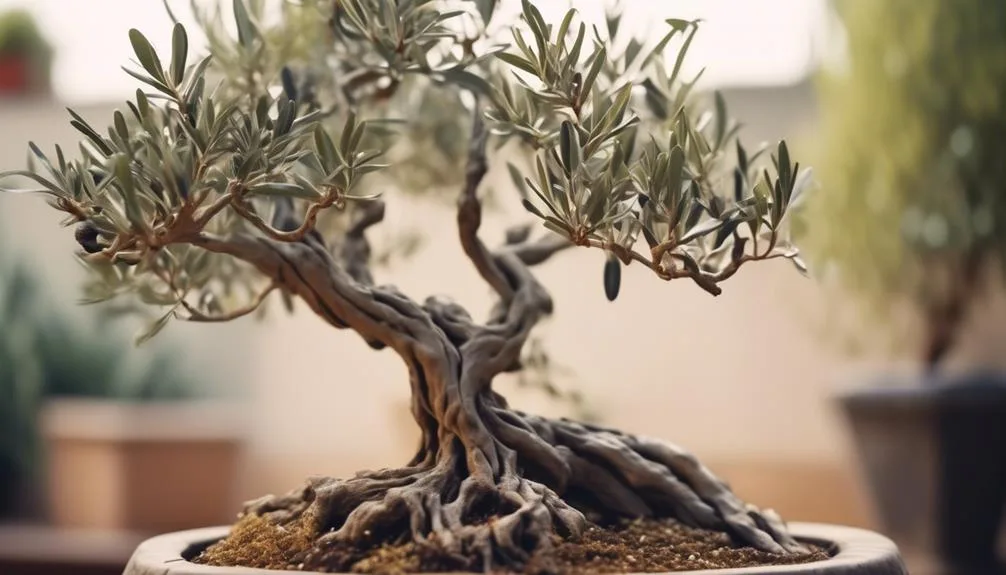Olive trees can actually be turned into bonsai, and the results can be amazing. It might seem challenging, but with the right techniques and a good variety of olive tree, you can create a stunning bonsai.
We'll explore the process of training and shaping an olive tree into a bonsai, and uncover the secrets to success. Let's see how this delicate art form can transform a regular olive tree into a captivating bonsai specimen.
Key Takeaways
- Compact and slow-growing olive tree varieties like 'Little Ollie' and 'Swan Hill' are suitable for bonsai.
- Techniques such as pruning, wiring, root pruning, and repotting are essential for training olive trees into bonsai.
- Regular watering, well-draining soil, and proper soil composition (akadama, pumice, and lava rock) are crucial for maintaining bonsai olive trees.
- Pruning regularly, using sharp tools, considering unique characteristics, and practicing patience and observation are important for shaping bonsai olive trees.
Suitable Olive Tree Varieties for Bonsai
When choosing olive tree varieties for bonsai, it's important to select compact and slow-growing cultivars that are well-suited for the art of bonsai. Olive trees are ideal for bonsai due to their naturally small leaves and branches, making them perfect for creating the illusion of a mature tree in miniature form.
Opt for olive tree varieties that have naturally small leaves and a slow growth habit, such as the 'Little Ollie' or 'Swan Hill' cultivars. These varieties are well-suited for bonsai as they maintain a small and manageable size, making them perfect for creating miniature garden ideas.
Their compact nature allows for intricate shaping and pruning, essential for bonsai. With these varieties, you can craft stunning olive tree bonsai that bring the beauty of the Mediterranean into your home.
Techniques for Training Olive Trees Into Bonsai
To train olive trees into bonsai, you can employ various techniques that allow for shaping and pruning to achieve the desired miniature form with intricate details.
When styling olive trees into bonsai, consider using the following techniques:
- Pruning: Regularly prune the olive tree's branches to maintain the desired shape and size of the bonsai. This helps in controlling the tree's growth and encourages the development of a compact, miniature form.
- Wiring: Use wiring techniques to gently bend and shape the branches of the olive tree, creating elegant and artistic designs that reflect the natural growth patterns of mature olive trees.
- Root Pruning and Repotting: Periodically root prune and repot the olive tree into suitable bonsai containers to maintain its health and promote a balanced, harmonious appearance.
When selecting bonsai container options for olive trees, consider choosing shallow, wide containers to accommodate the tree's shallow root system and provide stability while enhancing aesthetic appeal.
Maintaining Bonsai Olive Trees
Maintaining bonsai olive trees requires regular watering, pruning, and careful monitoring of their growth and health to ensure they thrive in their miniature form.
Watering frequency is crucial for bonsai olives, as they need consistent moisture without becoming waterlogged. Water the tree thoroughly when the soil surface feels dry, but avoid letting the soil dry out completely.
It's important to use well-draining soil to prevent waterlogging, as bonsai olive trees are susceptible to root rot. A suitable soil composition for bonsai olive trees includes a mix of akadama, pumice, and lava rock to promote good drainage and aeration.
Regularly check the soil moisture and adjust your watering schedule accordingly to maintain the health and vitality of your bonsai olive tree.
Tips for Pruning and Shaping Bonsai Olive Trees
Considering the unique growth patterns of bonsai olive trees, it's essential to understand the best techniques for pruning and shaping to maintain their miniature, elegant form. Here are some tips to help you master the art of pruning and shaping bonsai olive trees:
- Pruning Techniques:
- Regularly prune new growth to maintain the desired shape and size of the bonsai.
- Use sharp, clean tools to make precise cuts, focusing on removing any unwanted branches and promoting a balanced canopy.
- Bonsai Styling:
- Experiment with different bonsai styles, such as formal upright, informal upright, or slanting, to bring out the natural beauty of the olive tree.
- Consider the tree's unique characteristics and adapt your styling to enhance its aesthetic appeal.
- Patience and Observation:
- Take your time to observe the tree's growth patterns and response to pruning.
- Patience is key in achieving the desired shape and form, so regularly assess and adjust your pruning techniques accordingly.
Potential Challenges in Bonsai Olive Tree Care
What are the potential challenges you might encounter when caring for a bonsai olive tree?
Two key challenges in bonsai olive tree care are soil composition and watering frequency. Olive trees prefer well-draining soil, so it's essential to ensure the soil mix is porous and provides good aeration for the roots. A mix of akadama, pumice, and lava rock is commonly used to achieve the ideal soil composition.
Additionally, managing the watering frequency can be tricky. Overwatering can lead to root rot, while underwatering can cause stress and affect the tree's health. Finding the right balance is crucial. It's important to monitor the soil moisture levels and adjust the watering schedule based on factors like temperature and humidity.
Conclusion
In the right hands, olive trees can be transformed into beautiful bonsai, adding a touch of elegance and nature to any space. With proper care and pruning, the unique character of a bonsai olive tree can flourish, rewarding enthusiasts with its beauty.
So why not try your hand at cultivating a mini olive tree and savor the tranquility it brings to your home?

